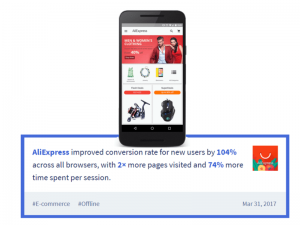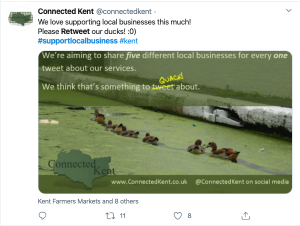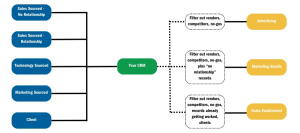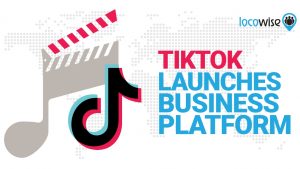We live in a world obsessed with leads. But are they actually worth your time and bucks? Does sales really care about the magnitude of leads marketing generates? Let’s break this down to see if leads have the impact that we’ve been brainwashed to believe. (Spoiler alert: they don’t.)
What Even Is a Lead?
Is it an email offering? A nurtured email? An MQL? An inbound request? …Yes. Basically, a lead is anyone who shows an interest in your offering. However, whether collected from form submissions, a purchased list or an event, less than 1% of all leads turn into sales. When they’re nurtured, 20% more turn into customers. (So roughly 1.2%.) They don’t sound that nurtured to us. Next, you convert them to an MQL to hand over to sales. The average lead-to-MQL conversion rate is 31%, which is decent. However, how specifically tailored is your lead scoring to meet MQL quotas, rather than to hand sales high quality potential customers?
There’s no denying that inbound requests are the “hot leads” sales are eager to receive. Unfortunately, 57% of the buyer’s journey is complete before filling out a form. 77% have already fully defined their needs and know what they want. So you never even get a chance to frame their perspective with your product or service in mind – meaning you’re less likely to win their business.
Also, it’s wild that there is no universal definition of a marketing lead. How are we obsessing over something we can’t even properly define?
Where Does This Leads Obsession Come From?
To put it briefly, 16 years ago marketing automation became all the rage to collect leads. SEO, landing pages, and form optimization became everything. However, since 2015 lead generation has been declining. Don’t panic, it’s ultimately a good thing! It’s made way for its cooler, younger, and in-the-know cousin: the more targeted and effective account-based marketing (ABM). Which brings us to our next point…
What Could We Possibly Measure Instead of Leads?
If leads are no longer the main goal for revenue, what should you focus on instead to measure success? And how can you optimize your program to create more qualified sales opportunities, faster?
Focus on account-based marketing just as much as you do on collecting leads and eventually, as your program matures, the focus shifts to these four ABM pillars:
- New business generation
- Pipeline acceleration
- Customer retention
- Customer expansion
Leads are great, but when less than 1% of them become customers, it’s an unreliable indicator of revenue performance. Our 2020 State of ABM report found that mature ABM programs are generating 78% of all sales opportunities and 73% of revenue without ever touching leads. Only 10% of mature ABM programs consider “leads” to be a top-3 performance indicator. Your favorite sales teammate would rather have ten opportunities than a hundred leads. And yes, we dare you to ask them yourselves.
Life Cycle Stages for Modern Go-to-Market Teams
Think of the 4 ABM life cycle stages as a pipeline rather than a funnel. Ditch the traditional marketing funnel and start measuring these stages instead. But first, decide your target accounts. A target account list is the number of accounts you’re targeting when running a coordinated campaign. You can optimize your target accounts by:
- Running a content audit
- Diversifying your segments
Learn more here on how to measure and optimize target accounts.
Awareness
In the first lifecycle stage of awareness, leverage firmographic and intent data to put highly relevant messages in front of your best-fit future customers via targeted display and social advertising. This generates initial interest and edges out competitors vying for the same attention. Start creating tight segments and associating personalized messages and you can experience huge lifts in display ad performance. Our research team found that industry or persona-specific ads perform twice as well as normal display ads and account-specific ads perform five times better!
Opportunity
Opportunities created are accounts that engage with your brand (both digitally and in person), show interest, and are qualified as a legitimate revenue opportunity.
Here’s where the magic happens. By sharing real-time engagement data with your sales team, as a marketer you can alert them to the accounts that see those ads and take action. Then your sales team can reach out, trusting that these prospects are already familiar with your brand and solution.
Pipeline Progression
Here you deliver personalized, mid-funnel content to buyers to expedite the sales process. By aligning relevant creative and content to discrete sales stages, you can automatically target accounts at each stage of your opportunity cycle.
Customer Retention + Expansion
In the final stage, create tight customer segments based off of customer data. Organize and group customer segments by NPS scores, product usage, contract renewal dates, or even contract type. With these clusters of customers, marketing can deploy product best practices and usage applications to customers who aren’t using your product as much as you’d like them to.
What’s Easier: Chasing Leads or Accounts?
Still not convinced that chasing leads is creating your whole team unnecessary extra work with less results? While we could spend the whole day convincing you, here’s our answer in a nutshell. You have to work really hard to nurture a bunch of wishy-washy (no offense) leads who may not even be the people who approve purchasing your product or service. It’s much safer to figure out your ideal future customer in advance and market to their buying committee as a whole, rather than just one person.
“But My CMO, CFO, CEO, Won’t Let Me Stop Measuring Leads.”
Of course, leads have been the main measure of marketing success for a hot minute, and changing this deep-rooted tactic won’t be easy. You’ll need to convince your revenue leaders that ABM is much more powerful and effective to grow a business. If they’re resistant, try these rebuttals:
- Anyone can generate leads– that’s not what revenue leaders want. They want a predictable pipeline that produces amazing results, i.e. big bucks and loyal, happy customers!
- An account-based approach is a way more efficient acquisition engine. Focus on fewer accounts and create bigger wins. The numbers don’t lie.
- Leads won’t stop coming in, but you won’t have to rely on them anymore.
- If your competitors perfect ABM before you, it’s too late. This is why you must become an early adopter.
- ABM produces a superior end-to-end customer experience. Let’s face it: everyone wants to feel special. ABM forces you to dig deep, learn what each buyer truly wants, and offer a customized buying experience that’s hard to ignore.
(57)
Report Post





